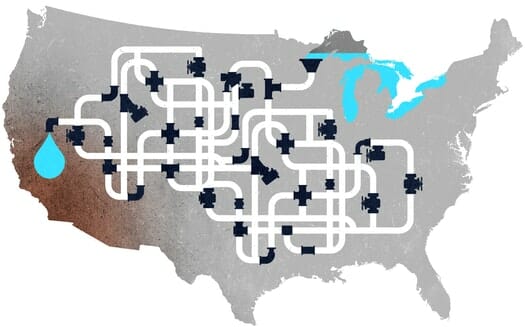Illustration by Rob Dobi for the Star Tribune
Outside Two Harbors, Minn., on a cliff overlooking the broad expanse of Lake Superior, you are overwhelmed by grandeur — shimmering water, crashing waves, a down-bound ore boat on the horizon, miniaturized by distance.
As you fill your senses, you may be unaware of the invisible others behind you — 2,000 miles or so behind you, to the southwest — eyeing the Great Lakes in another spirit, coveting all that water.
Lake Superior is big, all right. It and the other Great Lakes contain one-fifth of the whole world’s fresh water and, get this, hold enough to submerge the continental U.S. under 10 feet.
Those far-off onlookers thirst mightily for the Lakes’ 6.5 million billion gallons of fresh water that, to them, just sits there before running off to the ocean. Wasted. It’s easy for us lake-landers to dismiss such thoughts, but those in the American Southwest are up against a 17-year drought that keeps getting worse. After an unusually warm winter, it’s expected to worsen still more this summer due to a dearth of mountain snow that will again leave Colorado River flow far below normal, with forecasts of dry […]
Full article: The great siphoning: Drought-stricken areas eye the Great Lakes
More from the Anishinabek Nation and the Great Lakes:
Mayors, Anishinabek Nation Call for Stricter Rules in Great Lakes Withdrawals
Ojibwe Grandmother has walked 17,000 km to raise consciousness about water
Blue Water Bridge a potential crossing for U.S.-bound liquid nuclear waste
Controversial insecticides pervasive in Great Lakes tributaries
Antidepressants found in fish brains in Great Lakes region


